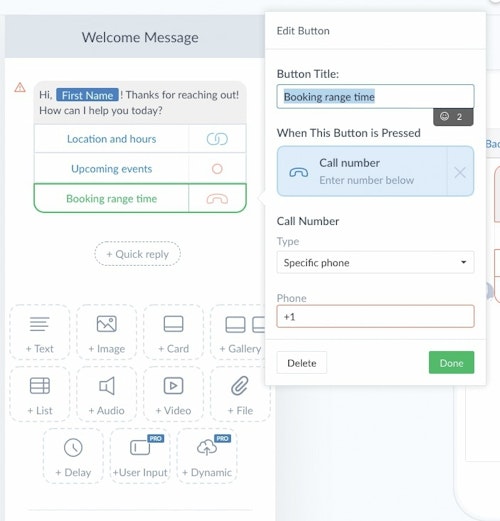Imagine a tool that would allow you to interact with customers and potential customers 24 hours a day, 7 days a week, could handle answering frequently asked questions, and could allow you to put personalized messages in front of your most active customers.
If that sounds good to you, then you should consider building your own chatbot.
I know — for small businesses that thrive on personal attention and one-on-one interaction, it’s hard to believe anything with the word “bot” in its name can be helpful. But a chatbot can actually increase the level of personal interaction you have with your customers. Thanks to chatbots, your business can be more responsive to customer questions, you can better tailor your marketing messages, and you’ll have more time for the hands-on interaction that really makes a difference.
What Is a Chatbot?
A chatbot is a computer program that can, as its name implies, chat with people. You have probably interacted with one in the past. Many companies use them to handle easily automated tasks, such as purchasing a product or booking a service. And while chatbots might seem on the surface to be advanced technology that only large companies can afford, there are now a number of services that allow even technologically challenged small business owners to build their own chatbots. Oh, and here’s the best part: Some of these services are free.
Okay . . . But Why Would I Want One?
The way people communicate is constantly evolving, and marketing strategies must change as well. When people wrote letters on paper to their friends, direct mail was a great option. When email was how people kept in touch, email marketing worked well. Today, more and more people are shifting to messenger apps.
How big are messenger apps? Craig Smith collected data on Facebook Messenger in a post called “60 Interesting Facebook Messenger Statistics and Facts” on ExpandedRamblings.com. Here are few highlights:
- 1.3 billion people worldwide use Facebook Messenger
- 11 percent of the world’s population uses Messenger monthly
- 20 billion messages are sent between users and businesses on Messenger every month
- 64 percent of monthly Facebook users also use Messenger
- 50 percent of U.S. teens use Messenger daily
Chances are, your customers are using a messenger app, which means that’s where you need to be if you want to reach them.
What’s more, chatbots also give you an edge on your competition. Because messenger marketing is still in its early stages, you’ll have the benefit of less “noise” and your message with have greater impact. Not convinced? This might help. According to MobileMonkey’s Larry Kim, those using messenger marketing are seeing open rates of 50 to 80 percent, with 20-plus percent response rates, with some marketers getting open rates up to 90 percent and response rates of 60 percent. Compare that to the dwindling open and response rates email marketers see today, and it’s clear messenger marketing is an exciting opportunity for the intrepid small business owner.

Getting Started With Chatbot
There are a number of services available that will allow you to create your own chatbot. Two of the most used are ManyChat (www.manychat.com) and Chatfuel (www.chatfuel.com).
ManyChat is considered by many to be one of the easiest platforms to use, and it offers a free version for up to 500 subscribers. This lets you try out a chatbot without having to invest any money. One downside to ManyChat is there is some noticeable ManyChat branding in the free version. You can remove the branding if you upgrade to the paid version. The cost of the paid version depends on the number of subscribers to your chatbot.
Chatfuel is more complicated, but it also offers more functionality so there are more things you can do with a Chatfuel bot. Like ManyChat, Chatfuel has a free version for you to try out before having to pay any money. Also like ManyChat, Chatfuel has its own branding in the free version.
For the purposes of this article, we’ll be looking at ManyChat simply because of its simple user interface.
To get started, you’ll need a Facebook business page. ManyChat will direct you to log in through Facebook, and it will, once given the necessary permissions, find any business pages associated with your Facebook account.
Greeting vs. Welcome
Once you have a ManyChat account established, you’ll be taken to your ManyChat Dashboard where you’ll be prompted to set up your greeting text and your welcome message. It’s a little confusing as greeting and welcome sound the same thing to me, but these are actually different messages with different purposes.
Your greeting text is what people will see before they click on your chatbot. This will be shown to mobile users and in the minimized chat window on desktop — if a desktop user expands the Messenger window, the greeting text will disappear.
Your welcome message, on the other hand, is the response users will see once they click “Get Started” on your chatbot. You can customize this message with the user’s name (I suggest using the “first name” option), and you can type in a fallback option for cases where the user’s first name is unavailable. For example, a good fallback option might be “Hi, there!” vs. “Hi, First Name!”
Next, you might thank the user for reaching out and ask how you can help them. This is especially useful if you tend to field the same questions through Facebook Messenger over and over again.
The Wall Street Journal, for example, uses a chatbot to interact with its readers. If you start to message the WSJ, you’ll get an immediate response with the page’s welcome message. Next, you’ll see links to articles that might interest you, followed quickly by a message saying you’ve subscribed to a daily briefing, letting you know how to unsubscribe, and asking you what news you’re interested in. Buttons beneath the last message will take you to what you’d like to see.
You, too, can use buttons to funnel users through your system. If a user wants to book time on your range, you can create a button that leads to your website or has the user call your shop. Users can make purchases and book reservations through chatbots; however, that option is not available through the free version of ManyChat.
ManyChat allows you to add sequences and steps, so your chatbot can be fairly comprehensive. If you feel overwhelmed, YouTube has a number of helpful videos that can walk you through specific questions or scenarios.

Messenger Marketing
Once you have your chatbot set up, you may decide to use it to reach out to your customers. Remember what I said earlier about open rates — messages sent through messenger apps have 80 to 90 percent open rates. Think about what that kind of exposure would do for your business.
The people who will receive your messages are the people who have opted in to your chatbot by clicking that “Get Started” link, so you don’t need to feel like you’re spamming cold leads. Instead, you can send follow-up messages to those warm leads that have already contacted you.
More importantly, messenger marketing allows you to segment your target audience so you can inform your customers about what matters to them. This is a big deal for archery retailers who are marketing to audience segments as vastly different as hard-core bowhunters vs. recreational or target shooters who might be turned off by hunting.
You can use your chatbot to help engage with consumers who click on a Facebook ad you’re running. If you have a slow day on your range, you can push out a message to consumers who’ve expressed interest in booking range time letting them know you have availability and offering a limited-time discount. It’s an exciting new tool that can help you reach more people more effectively.
Is a Chatbot Right for You?
Setting up a chatbot does take a little bit of time and there is a learning curve. Many of you might not want to invest the time and effort it takes to learn this new technology. And while I think it’s important for retailers to set up a website and learn some basic social media skills, I wouldn’t say chatbots belong in the “must-do” category just yet.
However, I do think that chatbots have a lot of potential as marketing tools, and forward-thinking companies will probably find new ways to use them in the future. Building and implementing your own chatbot could give you an edge right now, and might better position you to take advantage of new opportunities later. So if you have some time (or a tech-savvy friend in your life), chatbots are definitely worth a look.







